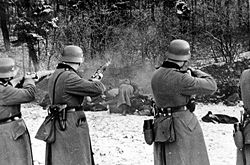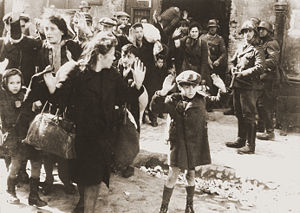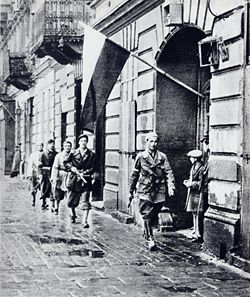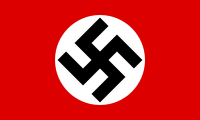General Government
|
|||||||||||||||||||||||||||||||||

The General Government (German: Generalgouvernement) refers to a part of the territories of Poland under German military occupation (that were occupied in September 1939) during World War II by Nazi Germany and was an autonomous part of "Greater Germany". In August 1941, former Polish voivodeships of Eastern Galicia (with a majority of Ukrainian population), which since September 1939 had been occupied by the Soviet Union (see: Soviet invasion of Poland) were added to the General Government (as Galicia District) by decree of Adolf Hitler. According to section III of the Fourth Hague Convention (1907),[1] accepted by Germany, all these acts were illegal from the beginning in the terms of international law (The Law of Nations), and civil law too. The area was not a puppet state and had no goal of collaborating with Poles throughout the war, regardless of their political orientation. Germans made a determined effort to avoid mentioning the word Poland in each and every document or administrative naming regarding the region, the only exception being the Germany-backed banknotes and coins (denominated 'zloty' and 'grosz') printed in 1940 where that word was used for propaganda purposes. The government and administration of General Government was composed entirely of Germans and the area was eventually to become a German province[2]. The only locals remaining would be those of German descent.
Contents |
Creation of the General Government













Hans Frank was appointed Governor-General of the occupied territories on 26 October 1939. Two decrees by Hitler (8 October and 12 October 1939) provided for the division of the annexed areas of Poland into the following administrative units:
- Reichsgau Wartheland (initially Reichsgau Posen), which included the entire Poznań Voivodeship, most of the Łódź Voivodeship, five counties of the Pomeranian voivodship, and one county of the Warsaw voivodship;
- the remaining area of Pomeranian voivodship, which was incorporated into the Reichsgau Danzig-Westpreussen (initially Reichsgau Westpreussen);
- Ciechanów District (Regierungsbezirk Zichenau) consisting of the five northern counties of Warszawa Voivodeship (Płock, Płońsk, Sierpc, Ciechanów and Mława), which became a part of East Prussia;
- Katowice District (Regierungsbezirk Kattowitz) or unofficially Ost-Oberschlesien (East Upper Silesia); together with western part of Małopolska, such as Sosnowiec, Będzin, Chrzanów, and Zawiercie counties and parts of Olkusz and Żywiec counties.
The area of these territories was 94,000 square kilometres and the population was about 10 million.
The remaining block of territory was placed under an administration called the General Government (in German Generalgouvernement für die besetzten polnischen Gebiete), with its capital at Kraków and subdivided into four districts, Warsaw, Lublin, Radom, and Kraków. After the German attack on the Soviet Union in June 1941, East Galicia, previously part of the Ukrainian SSR, was incorporated into the General Government and became its fifth district, the Galician District.
The General Government was a purely German administration, not a Polish puppet government. These territories were never intended as any future Polish state within German dominated Europe. In March 1941 Hitler made a decision to "turn this region into a purely German area within 15-20 years." He also explained that "Where 12 million Poles now live, is to be populated by 4 to 5 million Germans. The Generalgouvernement must become as German as Rhineland."[2]
Since fall 1939, Poles from other regions of Poland conquered by Germany were expelled to the General Government and the area was used as a slave labour camp from which men and women taken by force to work as slave laborers in the factories and on the farms in Germany.[2]
Population
The population in the General Government's territory was initially about 12 million, but this increased as about 860,000 Poles and Jews were expelled from the Germany-annexed areas and "resettled" in the General Government. Offsetting this was the German campaign of extermination of the Polish intelligentsia and other elements thought likely to resist. From 1941 disease and hunger also began to reduce the population. Poles were also deported in large numbers to work as forced labour in Germany: eventually about a million were deported, of whom many died in Germany.
In 1940 the population was divided into different groups. Each group had different rights, food rations, allowed strips in the cities, public transportation and restricted restaurants. Listed from the most privileged to the least:
- Germans from Germany (Reichdeutsche),
- Germans from outside, active ethnic Germans, Volksliste category 1 and 2 (see Volksdeutsche).
- Germans from outside, passive Germans and members of families (this group included also some ethnic Poles), Volksliste category 3 and 4,
- Ukrainians,
- Highlanders (Goralenvolk) - an attempt to split the Polish nation by using local collaborators
- Poles,
- Gypsies,
- Jews (eventually sentenced to extermination as a category).
Economics
Inhabitants of the GG were often forced to work for the Germans: see Baudienst and Forced labor in Germany during World War II.
Genocide policies
During the Wannsee conference on January 20, 1942, The State Secretary of the General Government, Dr. Josef Bühler pushed Heydrich to implement the "final solution" in the General Government. As far as he was concerned, the main problem of General Government was an overdeveloped black market that disorganised the work of the authorities. He saw a remedy in solving the "Jewish question" in the country as fast as possible. An additional point in favour was that there were no transportation problems here.
In 1942, the Germans began the systematic extermination of the Jewish population. The General Government was the location of four of the six extermination camps in which the most extreme measures of the Holocaust, the genocide by gassing of undesired "races", chiefly millions of Jews from Poland and other countries, was carried out between 1942 and 1944 .
Overall, 4 million of the 1939 population of the General Government area had lost their lives by the time the Soviet armed forces had taken the area in late 1944. If the Polish underground killed a German, 50--100 Poles were executed as a punishment and warning.[3]
It was German policy that a small number of (non-Jewish) Poles, like other Slavic peoples, were to be reduced to the status of serfs, while the rest would be deported or otherwise eliminated and eventually replaced by German colonists of the "master race." Various plans regarding the future of the original population were drawn, with one calling for deportation of about 20 million Poles to Western Siberia, and Germanisation of 4 to 5 million; although deportation in reality meant that the population wouldn't be removed but all of its members put to death as happened to other groups in execution of similar plans.[4] In the General Government, all secondary education was abolished and all Polish cultural institutions closed. In 1943, the government selected the Zamojskie area for further German colonisation. German settlements were planned, and the Polish population expelled amid great brutality, but few Germans were settled in the area before 1944 . See Generalplan Ost for more information about this.
Resistance
Resistance to the German occupation began almost at once (see: Henryk Dobrzański), although there is little terrain in Poland suitable for guerrilla operations. The main resistance force was the Home Army (in Polish: Armia Krajowa or AK), loyal to the Polish government in exile in London. It was formed mainly of the surviving remnants of the pre-War Polish Army, together with many volunteers. Other forces existed side-by-side, such as the communist People's Army (Armia Ludowa or AL), backed by the Soviet Union and controlled by the Polish Communist Party. By 1944 the AK had some 380,000 men, although few arms. During the occupation, the various Polish resistance organizations killed about 150,000 Axis soldiers. The AL was about 15% of the size of the AK.
In April 1943 the Germans began deporting the remaining Jews from the Warsaw Ghetto, provoking the Warsaw Ghetto Uprising, April 19 to May 16. That was the first armed uprising against the Germans in Poland, and prefigured the larger and longer Warsaw Uprising of 1944.
In July 1944, as the Soviet armed forces approached Warsaw, the government in exile called for an uprising in the city, so that they could return to a liberated Warsaw and try to prevent a Communist take-over. The AK, led by Tadeusz Bór-Komorowski, launched the Warsaw Rising on 1st August in response both to their government and to Soviet and Allied promises of help. However Soviet help was never forthcoming, despite the Soviet army being only 18 miles (30 km) away, and Soviet denial of their airbases to British and American planes prevented any effective resupply or air support of the insurgents by the Western allies. After 63 days of fighting the leaders of the rising agreed a conditional surrender with the Wehrmacht. The 15,000 remaining Home Army soldiers were granted POW status (prior to the agreement, captured rebels were shot), and the remaining civilian population of 180,000 expelled.
The end
As the Soviets advanced through Poland in late 1944 the General Government collapsed. Frank was captured by American troops in May 1945 and was one of the defendants at the Nuremberg Trials. During his trial he converted to Catholicism. Frank surrendered forty volumes of his diaries to the Tribunal and much evidence against him and others was gathered from them. He was found guilty of war crimes and crimes against humanity and on October 1, 1946, he was sentenced to death by hanging. The sentence was carried out on October 16.
See also
- World War II evacuation and expulsion
- Polish areas annexed by Nazi Germany
- Polish areas annexed by Soviet Union
- German camps in occupied Poland during World War II
- Ernst Lerch
- Gestapo-NKVD Conferences
References
- ↑ Laws and Customs of War on Land (Hague IV); October 18, 1907, The Avalon Project, Yale University
- ↑ 2.0 2.1 2.2 "Germany and Eastern Europe: Cultural Identities and Cultural Differences" by Keith Bullivant, Geoffrey J. Giles, Walter Pape, Rodopi 1999 page 32
- ↑ http://www1.yadvashem.org/odot_pdf/microsoft%20word%20-%206246.pdf
- ↑ HITLER'S PLANS FOR EASTERN EUROPE


